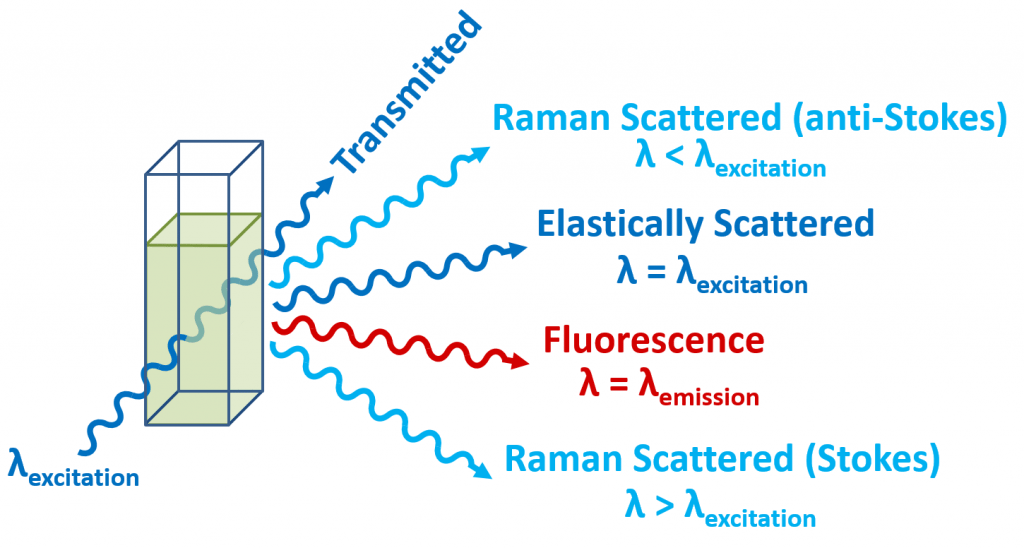Fluorescence – Physics Notes – For W.B.C.S. Examination.
প্রতিপ্রভ – পদার্থবিজ্ঞানের নোট – WBCS পরীক্ষা।
Fluorescence, emission of electromagnetic radiation, usually visible light, caused by excitation of atoms in a material, which then reemit almost immediately (within about 10−8 seconds).Continue Reading Fluorescence – Physics Notes – For W.B.C.S. Examination.
The initial excitation is usually caused by absorption of energy from incident radiation or particles, such as X-rays or electrons. Because reemission occurs so quickly, the fluorescence ceases as soon as the exciting source is removed, unlike phosphorescence, which persists as an afterglow. A fluorescent lightbulb is coated on the inside with a powder and contains a gas; electricity causes the gas to emit ultraviolet radiation, which then stimulates the tube coating to emit light. The pixels of a television or computer screen fluoresce when electrons from an electron gun strike them. Fluorescence is often used to analyze molecules, and the addition of a fluorescing agent with emissions in the blue region of the spectrum to detergents causes fabrics to appear whiter in sunlight. X-ray fluorescence is used to analyze minerals.
Fluorescence, a type of luminescence, occurs in gas, liquid or solid chemical systems. Fluorescence is brought about by absorption of photons in the singlet ground state promoted to a singlet excited state. The spin of the electron is still paired with the ground state electron, unlike phosphorescence. As the excited molecule returns to ground state, it involves the emission of a photon of lower energy, which corresponds to a longer wavelength, than the absorbed photon.
The energy loss is due to vibrational relaxation while in the excited state. Fluorescent bands center at wavelengths longer than the resonance line. This shift toward longer wavelengths is called a Stokes shift. Excited states are short-lived with a lifetime at about 10-8 seconds. Molecular structure and chemical environment affect whether or not a substance luminesces. When luminescence does occur, molecular structure and chemical environment determine the intensity of emission. Generally molecules that fluoresce are conjugated systems. Fluorescence occurs when an atom or molecules relaxes through vibrational relaxation to its ground state after being electrically excited. The specific frequencies of excitation and emission are dependent on the molecule or atom.
Stage 1: Excitation
A photon of energy hνEX is supplied by an external source such as an incandescent lamp or a laser and absorbed by the fluorophore, creating an excited electronic singlet state (S1‘). This process distinguishes fluorescence from chemiluminescence, in which the excited state is populated by a chemical reaction.
Stage 2: Excited-State Lifetime
The excited state exists for a finite time (typically 1–10 nanoseconds). During this time, the fluorophore undergoes conformational changes and is also subject to a multitude of possible interactions with its molecular environment. These processes have two important consequences. First, the energy of S1‘ is partially dissipated, yielding a relaxed singlet excited state (S1) from which fluorescence emission originates. Second, not all the molecules initially excited by absorption (Stage 1) return to the ground state (S0) by fluorescence emission. Other processes such as collisional quenching, fluorescence resonance energy transfer (FRET)) and intersystem crossing (see below) may also depopulate S1. The fluorescence quantum yield, which is the ratio of the number of fluorescence photons emitted (Stage 3) to the number of photons absorbed (Stage 1), is a measure of the relative extent to which these processes occur.
Stage 3: Fluorescence Emission
A photon of energy hνEM is emitted, returning the fluorophore to its ground state S0. Due to energy dissipation during the excited-state lifetime, the energy of this photon is lower, and therefore of longer wavelength, than the excitation photon hνEX. The difference in energy or wavelength represented by (hνEX – hνEM) is called the Stokes shift. The Stokes shift is fundamental to the sensitivity of fluorescence techniques because it allows emission photons to be detected against a low background, isolated from excitation photons. In contrast, absorption spectrophotometry requires measurement of transmitted light relative to high incident light levels at the same wavelength.
Fluorescence Spectra
The entire fluorescence process is cyclical. Unless the fluorophore is irreversibly destroyed in the excited state (an important phenomenon known as photobleaching, see below), the same fluorophore can be repeatedly excited and detected. The fact that a single fluorophore can generate many thousands of detectable photons is fundamental to the high sensitivity of fluorescence detection techniques. For polyatomic molecules in solution, the discrete electronic transitions represented by hνEX and hνEM in are replaced by rather broad energy spectra called the fluorescence excitation spectrum and fluorescence emission spectrum, respectively). The bandwidths of these spectra are parameters of particular importance for applications in which two or more different fluorophores are simultaneously detected (see below). The fluorescence excitation spectrum of a single fluorophore species in dilute solution is usually identical to its absorption spectrum. The absorption spectrum can therefore be used as a surrogate excitation spectrum data set. Under the same conditions, the fluorescence emission spectrum is independent of the excitation wavelength, due to the partial dissipation of excitation energy during the excited-state lifetime, as illustrated in . The emission intensity is proportional to the amplitude of the fluorescence excitation spectrum at the excitation wavelength.
Please subscribe here to get all future updates on this post/page/category/website


 Toll Free 1800 572 9282
Toll Free 1800 572 9282  mailus@wbcsmadeeasy.in
mailus@wbcsmadeeasy.in



















































































































